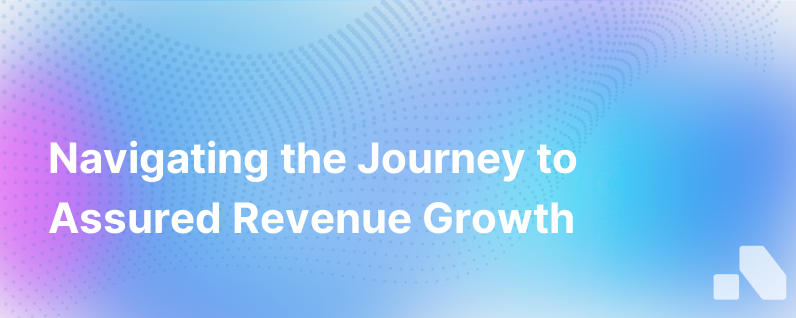The Path To Revenue Confidence
Published on December 19, 2023 by Sawyer Middeleer
Incremental gains and pivots in strategy define the growth trajectory of any ambitious B2B startup. However, amidst all the experimentation and hustling, there's one holy grail that all startups seek — revenue confidence. Achieving it means your business can predictably forecast earnings and make sound investments in its future growth without undue fear of unexpected shortfalls.
So what's the path to securing this coveted revenue confidence, and how can a startup achieve it amidst a landscape that's fraught with uncertainties? Well, the journey is not without its bumps, but it can surely be navigated with the right strategies and tools.
Understanding the Importance of Revenue Confidence
Revenue confidence isn't just about having a hunch that your sales will go up. It's about knowing with certainty that your revenue streams are stable, predictable, and on a growth trajectory. It's the knowledge that allows for strategic hiring, investment in product development, and capitalization on market opportunities.
In essence, revenue confidence enables a business to:
- Make informed strategic decisions
- Forecast growth and performance with more accuracy
- Instill investor confidence
- Effectively allocate resources for maximum ROI
- Control the narrative regarding future potential and sustainability
Now, how does a B2B startup set foot on this path? The journey encompasses the following steps.
Steps to Build Revenue Confidence
1. Harnessing Data for Predictive Analytics
The foundation of revenue confidence is solid data. Startups must leverage analytics tools to gather and interpret data that can lead to predictive modeling. As the adage goes, "you can't manage what you can't measure." Proper data management allows startups to:
- Assess sales trends and seasonality
- Identify successful sales and marketing tactics
- Understand customer behavior and lifecycle trends
2. Strengthening Your Sales Process
With data in hand, the next step is to create or iteratively refine a robust sales process. This process should be scalable, repeatable, and consistently applied across the sales team. It encompasses:
- Lead qualification frameworks to focus on high-potential leads
- A structured sales pipeline with clearly defined stages
- Sales methodologies backed by training and tools
- Regular analysis of sales metrics to identify bottlenecks
3. Embracing Sales and Marketing Alignment
Misalignment between sales and marketing can lead to inefficiencies and loss of potential revenue. To be confident in your revenue stream, your marketing campaigns must feed quality leads into the sales pipeline, and your sales team must effectively convert these leads into customers. Coordination ensures:
- Messaging consistency
- Efficient lead handovers
- Shared goals and KPIs
4. Client Retention and Success Focus
Acquiring new clients is expensive; retaining existing ones is key to steady revenue. Build programs aimed at customer success and loyalty; this might include:
- Regular communication and check-in
- Offering additional value through content and resources
- Upselling and cross-selling to increase customer lifetime value
5. Leveraging Automation and CRM Platforms
Investing in CRM and other automation tools is non-negotiable for modern businesses wishing to scale. Such platforms provide:
- Streamlined customer data management
- Automation of mundane tasks for sales and marketing
- Better lead management and follow-up procedures
6. Create Flexible Financial Modeling
Revenue confidence also requires a financial model that can adapt to the realities of your sales performance and allow for scenario planning. A good financial model helps a business:
- Forecast revenue under different scenarios
- Plan for cash flow requirements
- Make informed budgetary decisions
7. Prioritizing Transparency and Communication
Transparent communication, both internally and with stakeholders, helps build trust and ensure that everyone is on the same page. This includes:
- Open sharing of performance data
- Celebrating wins and learning from losses as a team
- Having clear communication channels for feedback
8. Investing in Continued Learning and Development
Finally, in an ever-evolving marketplace, continuous learning and skills development are essential. You can be confident in your revenue if your team is adept at using the latest tools, understanding new market trends, and implementing best practices.
How Aomni Fits Into the Path to Revenue Confidence
One way to accelerate along this path is by leveraging AI platforms such as Aomni. Aomni can seamlessly integrate into your sales process, offering real-time account research, competitive insights, and personalized sales content—all with zero effort required. With Aomni, startups can enjoy:
- Swift access to comprehensive market and customer data
- Automated updating of sales collateral to align with real-world insights
- AI-driven analysis that can guide strategic decision-making
Conclusion
Establishing revenue confidence is a blend of science and art. It calls for a data-savvy, customer-focused approach, and a willingness to embrace technology and change. While the journey to revenue confidence is ongoing, embracing these steps can ensure you're on the right path, making decisions not just based on past performance, but on predictive insights that anticipate future trends.
Startups can expedite their path to revenue confidence by leaning into platforms like Aomni, taking advantage of advanced AI tools to streamline sales processes, and ultimately lock in the predictable and growing revenue streams that will empower your future business decisions.